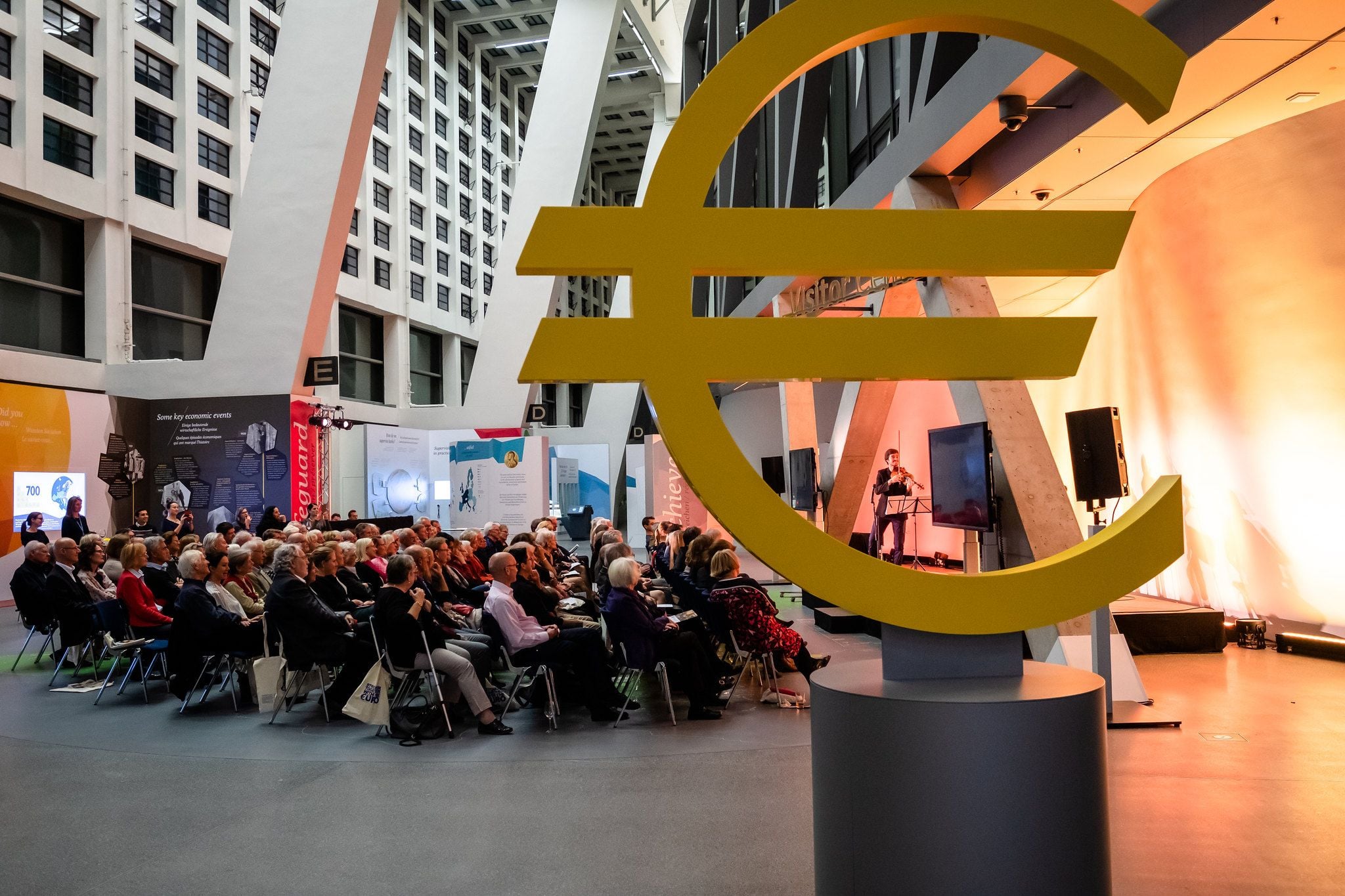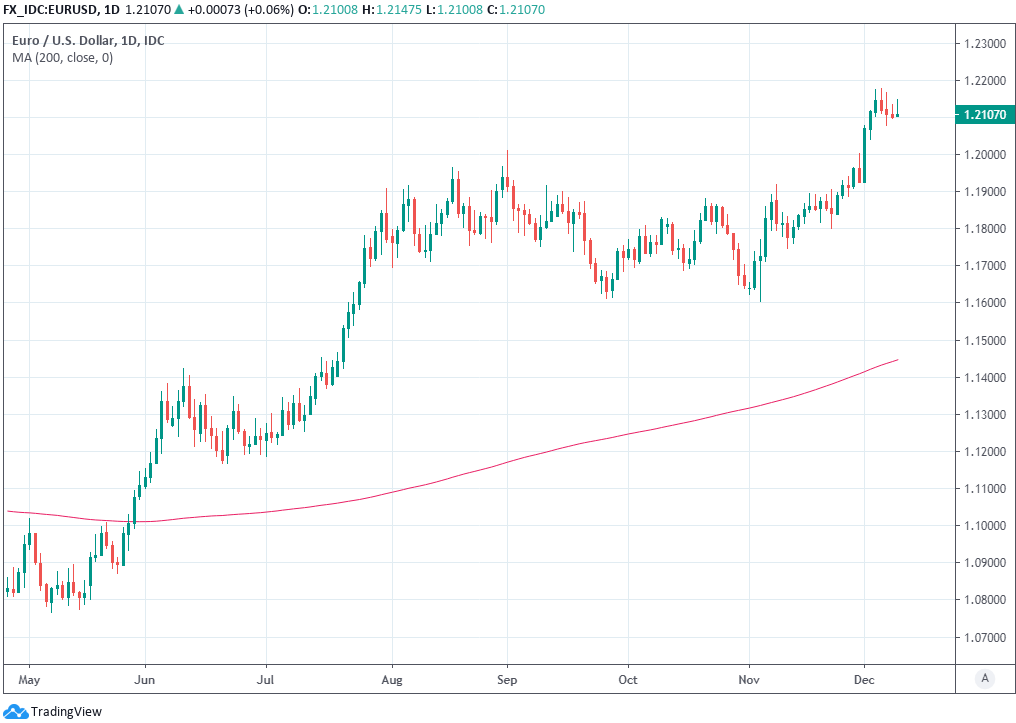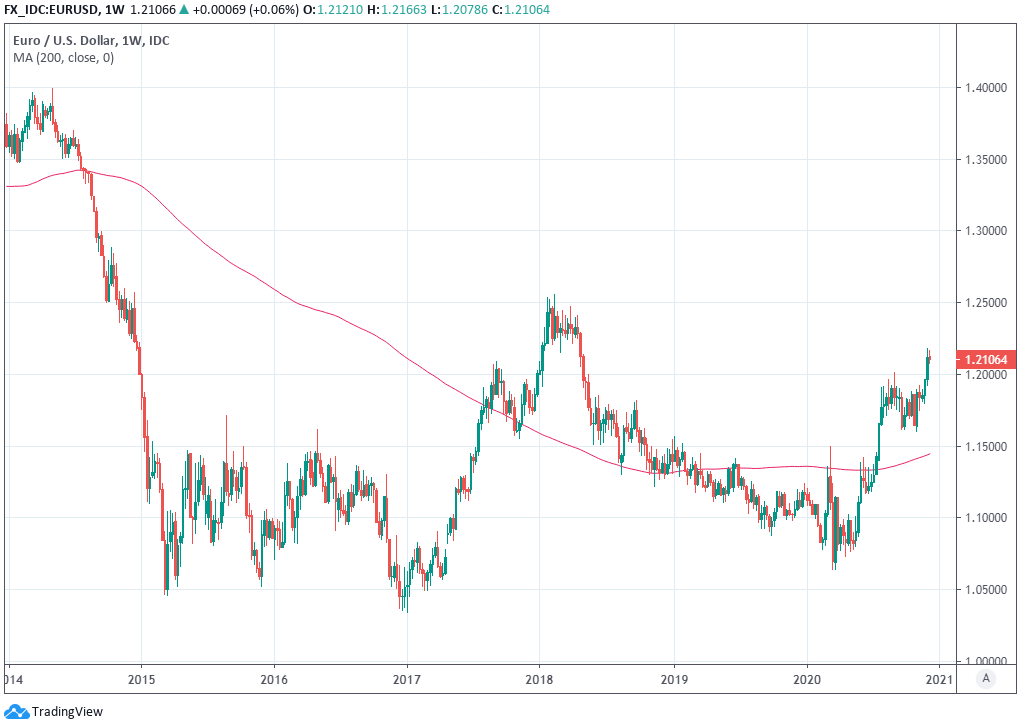Euro-Dollar Seen at 2014 Heights if Yuan and Sterling Keep Rallying Next Year
- Written by: James Skinner

Image © European Central Bank
- EUR/USD spot rate at time of writing: 1.2109
- Bank transfer rate (indicative guide): 1.1660-1.1755
- FX specialist providers (indicative guide): 1.1941-1.2005
- More information on FX specialist rates here
The Euro-Dollar rate was on its front foot Wednesday but could rise further next year, potentially reversing the 2015 decline induced by the European Central Bank (ECB) quantitative easing according to some forecasters, although EU leaders will first need to decisively extinguish a pair of political panfires.
Europe's unified unit advanced against most of its major rivals as investors wagered that, among other things, simmering political conlficts in Europe are nearing imminent resolution.
Most notably for the Eurozone; Poland, Hungary and Germany's Chancellor Angela Merkel were reported to be on the verge of a compromise relating to new conditions for accessing EU budget funding following a row over how Brussels' 'rule of law' is interpreted and applied.
Poland's Deputy Prime Minister reportedly to have said Wednesday "the alternative for the United Right government would be early elections which would not serve Poland well during a pandemic," after indicating that an agreement has been reached.
"This should be formalized at the EU leaders summit that starts tomorrow," says Bipan Rai, North American head of FX strategy at CIBC Capital Markets. "Reflation trade tailwinds should bolster EUR/USD demand as should a US stimulus deal. For now we are watching to see if the market will take out ytd highs at 1.2178, which has failed to break over three sessions last week. Weak support comes at the 1.2080 area."
The two members have threatened to veto the EU's next budget and its coronavirus recovery fund as a result of terms they fear will be used to coercively impose unwanted European policies, but have risked depriving others of key funding as well as a partial government shutdown in Brussels.
Above: Euro-to-Dollar rate shown at daily intervals.
Thursday's summit is also when investors and analysts hope to see a Brexit trade agreement signed off by EU leaders, which is why Prime Minister Boris Johnson was on route to Brussels for evening talks on Wednesday with European Commission chief Ursula Von Der Leyen.
The latest leaders' gathering will play out alongside a European Central Bank meeting where monetary policymakers are expected to increase the size of the bank's bond buying programme, which may bring volatility to Euro exchange rates on the day and ahead of the weekend.
But with the Brexit and budget panfires steadily being extinguished and a coronavirus vaccine being in the early stages of a global rollout since the first shot was delivered in a non-research setting on Tuesday, the road toward a global economic recovery is becoming clearer for investors.
"The EU’s exposure to China’s recovery could help it outperform the US. With China’s recovery on a more stable path, countries with exposure may be the out performers of 2021. Exports to China matter much more to Europe’s growth than it does for the US, with Germany’s exports to China representing 3% of GDP versus the US at 0.6%," says Jordan Rochester, a strategist at Nomura, who forecasts a Euro-Dollar rally from 1.23 at year-end to 1.27 before the curtain closes on 2021. "Political change and a return to austerity remain the largest risks for the Euro area."
{wbamp-hide start} {wbamp-hide end}{wbamp-show start}{wbamp-show end}
Europe's single currency has already risen 8% against the Dollar this year, inciting protest from a deflation fearing ECB in the process, so its continued rally next year depends in no small part on on the behaviour of other currencies including the Chinsese Yuan and Pound Sterling.
"Vaccines are good for humanity and for the global economy’s prospects, but they aren’t good for the dollar," says Kit Juckes, chief FX strategist at Societe Generale. "The euro wins because the dollar loses, and even then, the degree to which EUR/USD rises will depend on how much more the yuan is allowed to appreciate. Our forecasts suggest that this will be a brake on the euro, but we have above-consensus forecasts for EUR/USD."
Broader currency market considerations are important for the Euro-to-Dollar rate outlook because too strong a rally could necessitate a self-defeating policy response from an ECB concerned about the deflationary incitement of cheaper imports, all the while crimping the competitiveness of Eurozone exports.
A stronger Yuan and recovered Pound would mean the currencies of Europe's two largest trading partners have also risen and, as a result, that increases in the overall Eurozone exchange rate are limited even if the Euro charges higher against the Dollar again in 2021.
Above: Euro-to-Dollar rate shown at weekly intervals.
"Sterling has the third-largest weight in the TWI basket for the eurozone, behind the Chinese yuan and US dollar. It is currently, in real terms, about 4% cheaper than the average of the last decade. A no-deal UK exit from the EU would probably see a 5% or so fall for sterling in pretty short order and add further upward pressure on the euro. A deal, and a further sterling rally, would definitely help the eurozone and allow EUR/USD to move higher," Juckes says.
Societe Generale forecasts the Euro-to-Dollar rate will end 2021 at 1.27, its highest since the closing months of 2014 and before the ECB first announced in January 2015 that it would resort to quantitative easing as means of stoking the faster economic growth deemed necessary to meet its 2% inflation target.
But for the time being at least, much of the extended rally is expected to be power by Dollar sales and depreciation for which the Euro is a natural outlet for. The Dollar is estimated to be overalued by as much as 10% following years of economic outperformance that led the build up of a far superior pre-pandemic interest rate differential.
But with interest rates on boths sides of the Atlantic now on the floor, relative economic growth rates are seen mattering less in 2021 than in prior years. This is expected to facilitate a steady and ongoing outflow of investor money from the greenback, and inflows into other, possibly more greener pastures elsewhere.
"This is likely to take time to happen. Apart from anything else, no-one else wants to see their currency appreciate," Juckes says. "The more broad-based and stronger the global recovery, the faster the dollar can fall, in part because dollar weakness can be spread out more. The US’s four biggest trading partners – the eurozone, China, Canada and Mexico – all trade with a lot of other countries and won’t want their currencies to appreciate too much against those of their trading partners."






